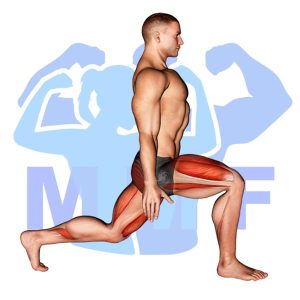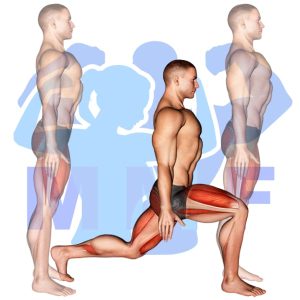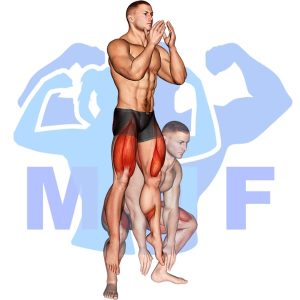Are you feeling frustrated with your lunges? Do you find yourself struggling to perform this classic exercise correctly? Don’t worry, you’re not alone. Despite being a staple move for lower body strength training, lunges can be tricky to master. The culprit of this challenge often has to do with weak stabilizing muscles in the hips and core. But fear not, in this blog post, we’ll walk you through how to properly execute a lunge and provide tips for strengthening those muscles so you can perform lunges with ease.
Lunge Summary
- Primary Muscles: Gluteus Maximus
- Secondary Muscles: Adductor Magnus, Quadriceps, and Soleus
- Equipment: Body Weight
- Mechanics Type: Compound
- Force: Push
- Utility: Auxiliary

Lunge Instructions
- Start by standing up straight and stepping out with one leg in a long stride.
- Now lunge by lowering your back knee towards the ground while bending your front knee.
- Next, press yourself all the way back to a standing position.
- Here, you have two options, you can continue doing lunges with the same leg or alternate your legs.
- Repeat your Lunges for complete sets of equal reps on with both legs.
Video Tutorial
Lunge Muscles
Target (Agonist)
Synergists
- Adductor Magnus
- Quadriceps
- Soleus
Dynamic Stabilizers
Stabilizers
Antagonist Stabilizers
- None

Benefits of Lunge
The Lunge is a great exercise for targeting the Gluteus Maximus, which is the largest muscle in the body. This muscle is responsible for hip extension, abduction and external rotation. When performing a Lunge, the Gluteus Maximus works to keep the torso upright and stable while the hips are moving. Additionally, the Lunge increases hip stability, which can help prevent common injuries like ACL tears. Furthermore, performing Lunges helps to improve flexibility, power and overall athleticism. Finally, Lunges are a great exercise for building strength and increasing muscle size in the glutes.
Tips for Performing Lunge
Your at the right place if you’re trying to enhance your lunge performance. These tips can get you more out of this effective workout, and help you reap all the benefits it has to give. Concurrently with strengthening your glutes muscles, improving movability, and also a lower chance of injury can all be accomplished with this exercise. Let’s get started and take a look at how these tips will benefit you.
- Keep your back straight: Maintaining proper posture during a lunge will ensure that your glutes and quads are doing the work and will maximize the benefits from the exercise.
- Focus on your balance: Balancing your weight between both legs while lunging will help you to engage the right muscles and stay safe while doing the exercise.
- Slow and controlled: Slowing down the movement will not only help you to stay in control, but it will also help you to get the most out of the exercise and really feel it in your muscles.
Benefits and Tips Video
Frequent Mistakes To Avoid
Avoiding common errors can mean the difference between a productive workout and an injury when executing lunge. Additionally, achieving optimal results from this exercise requires proper form, and avoiding make any typical mistakes can allow you to perform the exercise better and obtain optimal results. Not only can preventing these errors make you stronger, but it can also assist in you feeling more assured and inspired when at in the gym. So it is time for you to optimize the impact of this exercise and experience the advantages of a successful workout.
- Not using the proper form: People often make the mistake of not using the proper form when conducting a lunge, which can lead to poor results and potential injury.
- Not controlling the movement: People often rush through the lunge, not controlling the movement and using momentum instead of strength to power them through. This can be dangerous and does not provide any real benefit.
- Not engaging their core: People often forget to engage their core when performing a lunge, which can lead to a weaker overall performance and can put strain on other parts of the body.
Find More Bodyweight Exercises Here
Variations and Complementary Exercises
Lunges are a great way to target and strengthen the major muscles in your legs, but they can become monotonous over time. Fortunately, there are a few variations and complementary exercises you can use to spice up your routine. Below are some alternative exercises that work similar muscles as the exercise Lunge.
Rear Lunge

The Rear Lunge is a great complementary exercise to the traditional lunge. It targets the same muscle groups and helps to build balance, strength and stability in the lower body. The Rear Lunge focuses more on the glutes and hamstrings, while the traditional lunge works more on the quadriceps. Performing both exercises as part of a regular workout routine can help to build strength and endurance in the lower body and improve performance. Furthermore, the Rear Lunge can be an alternative to the traditional lunge for those who are new to exercise, have lower body injuries, or are simply looking for a change of pace.
Walking Lunge

Walking Lunge is a great complementary or alternative exercise to the traditional lunge. Unlike a stationary lunge, which is done in one place, Walking Lunge involves taking a step forward while doing the lunge. This can be done with either one foot or two feet. The movement is more dynamic and adds a cardiovascular element to the exercise. It also allows for more range of motion and can target different muscle groups. Walking Lunges are a great way to increase the intensity of your workout and challenge your body in a different way.
Barbell Forward Lunge

The Barbell Forward Lunge is a great complementary or alternative exercise for the traditional Lunge. It is performed with a barbell placed on the back of the shoulders, and requires the lifter to take a large step forward and lower the body until the back knee almost touches the floor. The Barbell Forward Lunge works the same muscles as the traditional Lunge, but also engages more of the quadriceps muscles, making it a great alternative if you are looking to target those muscles more. Additionally, this exercise allows for heavier weights to be used, which can add an extra challenge to your routine.
Check Out These Top Bodyweight Exercises
Barbell Lateral Lunge

The Barbell Lateral Lunge is an excellent complement or alternative to the standard lunge exercise. This exercise involves stepping out to one side with the barbell in hand, dropping down into a squat position with the opposite leg straight, and then pushing back up to the starting position. It works all the same muscles as a regular lunge, but with the added bonus of improving balance and coordination while also recruiting more muscles in the hip, glutes, and core. This exercise is great for building strength, stability, and power in the lower body.
Barbell Rear Lunge

The Barbell Rear Lunge is a great complementary or alternative exercise to the Lunge. It works the same muscles as the Lunge, but it also involves the upper back and arms. The Barbell Rear Lunge is performed by standing with feet hip-width apart, holding a barbell with an overhand grip behind the back of the shoulders. Then, keeping the back straight, take a step back and lower the body until the rear knee is just above the ground. Push through the front heel and drive up to return to the starting position. This exercise is great for building strength in the legs and glutes while also engaging the core muscles.
Barbell Reverse Lunge

The Barbell Reverse Lunge is an exercise that is a great complement or alternative to the regular lunge. It is a compound exercise that targets the glutes, quads, hamstrings and core muscles. The exercise is done by standing upright with a barbell across your shoulders, stepping back with one leg, and then lowering your body until the front knee is bent at a 90-degree angle. To complete one rep, stand back up and repeat on the other side. This exercise helps to strengthen the legs and glutes while also helping to improve balance and stability.
Find More Glutes Exercises Here
Opposing Complementary Exercises
In order to maximize the effectiveness of the lunge exercise, it is important to work the opposite muscle groups as well. Here is a list of exercises that will help to strengthen the opposing muscles:
Squat Jump

Squat Jump is an effective and dynamic exercise that complements the Lunge, as it works the opposing muscle group. Squat Jump targets the glutes, quads, and hamstrings, while the Lunge strengthens the hip flexors, glutes, and quadriceps. Squat Jump is a great way to increase strength and power in the lower body, as well as improving balance and coordination. It also helps to increase mobility in the hips and core, which is essential for proper form in many other exercises. By doing Squat Jump and Lunge together, you can create a balanced workout that will leave your lower body feeling strong and powerful.
Squats With Bands

Squats With Bands is a great complementary exercise to the Lunge because it uses opposing muscle groups. Squats with Bands focuses on the quadriceps, glutes, and hamstrings whereas the Lunge works the hip flexors and glutes. Squats with Bands also works the core muscles, which helps to stabilize the body during the movement. By performing both exercises in succession, you can effectively target all major muscle groups in your lower body.
Barbell Front Squat Clean Grip

The Barbell Front Squat Clean Grip is a great way to build core strength and target the quads and glutes. By using a barbell, it increases the load and engages more muscles. This exercise can be used to complement the Lunge, as it works the opposing muscle group. While the Lunge targets the hamstrings, the Barbell Front Squat Clean Grip works the quads and glutes. This will help to create balance in the body and ensure that all muscle groups are being worked. Additionally, it will help to improve overall stability, power and mobility in the lower body.
Step Up Your Fitness Game with Lunges
If you’re looking to level up your fitness routine, lunges are a great way to challenge your legs and glutes. Plus, they can be done anywhere, with or without weights. Lunges target multiple muscle groups in your lower body, such as your quads, hamstrings, and glutes. These muscles are essential for everyday movements like walking, running, and jumping. By incorporating lunges into your workout, you can improve your overall leg strength, balance, and coordination. Start with a few sets of lunges each week and gradually increase the number of reps or sets as you get stronger.
References: Wikipedia | ExRx.net | PubMed.gov | Comprehensive List of Glutes Bodyweight Exercises




